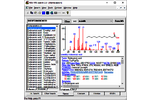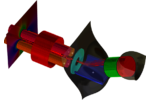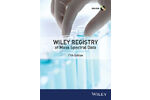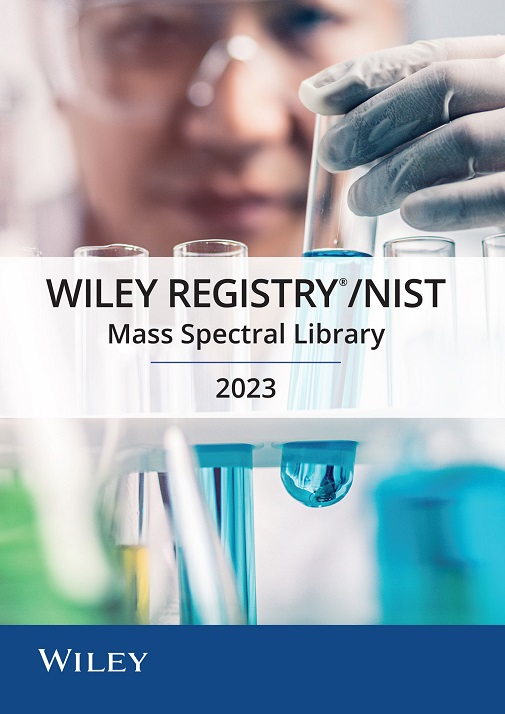Description
Introducing the Wiley Registry of Mass Spectral Data, 2023 edition:
- World's largest library of electron ionization (EI) mass spectra
— 1,180,800 spectra for 950,200 unique compounds.
It enables you to
identify global unknown compounds from EI mass spectra,
with the highest likelihood given its unparalleled size and breadth.
- Most spectra are accompanied by searchable chemical structure, trivial name, molecular formula, molecular weight, nominal mass and base peak.
- Applications include untargeted GC/MS screening of EI spectra, accurate mass workflows with MS-TOF spectra, and identification with other search constraints.
- Developed over 40 years by Wiley and Dr. Fred McLafferty Spectra are sourced from leading laboratories throughout the world.
- Uses the same search software as the NIST 23 spectral library and compatible with most MS data systems.
Identification of unknowns begins with untargeted analysis. The Wiley Registry provides researchers with the most assurance that their untargeted spectral search is the broadest available. The Wiley Registry™ of Mass Spectral Data is one of the most trusted and comprehensive mass spectral libraries in the world, and the gold standard for detection, identification and quantification in
|
|
Combine it with NIST 23! NIST 23 is a smaller but strongly trusted mass spectral library, which can be purchased separately (as a separate database) or optionally combined with Wiley Registry in a single database removing duplicate spectra (de-duplicated) for improved spectral searching. A separate original copy of NIST is included with the combined library.
Statistics
| Wiley/NIST 2023 | Wiley 2023 | Wiley 12th | Wiley 12th /NIST20 | Wiley 11th | Wiley 11th /NIST17 | Wiley 10th | Wiley 9th | Wiley 8th | Wiley 7th | Wiley 11th /NIST14 | Wiley 10th /NIST14 | Wiley 10th /NIST12 | Wiley 9th /NIST11 | Wiley 9th /NIST08 | Wiley 8th /NIST08 | Wiley 8th /NIST05 | Wiley 7th /NIST05 | Wiley 7th /NIST02 | |
|---|---|---|---|---|---|---|---|---|---|---|---|---|---|---|---|---|---|---|---|
| Total spectra | 1,180,000 | 873,300 | 817,290 | ? | >775,500 | 1,0007,924 | 719,000 | 662,000 | 399,383 | 338,000 | 977,559 | >950,000 | >918,000 | >800,000 | 796,000 approx | 562,000 | 532,573 | 461,000 | 444,000 |
| Unique compounds | 950,200 | 741,000 | 668,435 | ? | >599,700 | >730,000 | >638,000 | 592,000 | 310,000 | 289,000 | 707,501 | >760,000* | ~736,000 | >680,000 | 667,000 approx | (not listed) | (not listed) | (not listed) | 360,000 |
| Spectra w/ drawn structures | 1,148,600 | 841,100 | 785,061 | ? | >741,000 | 973,336 | 684,000 | 565,000 | 182,000 | 184,000 | 943,000 | >880,000 | >877,000 | 770,000 approx | 746,000 approx | 360,000 | 319,256 | (not listed) | 229,000 |
| GC RI Compounds | 180,618 | none | none | 111,788 | none | 99,400 | none | none | none | none | 82,337 | 82,337 | 70,838 | 70,838 | 44,000 | 44,000 | none | none | none |
| Spectra Type | 70eV EI mass spectra. Versions with NIST include MS/MS spectra and GI/RI data as well. |
||||||||||||||||||
| Footnotes: * Total unique compound count included NIST GC/RI ions in previous version statistics. | |||||||||||||||||||
See also the list of compound classes represented in the Wiley Registry 12 database (older stats).
What's New
Improvements in the 2023 Edition
- Addition of over 74,000 unique compounds and over 91,900 spectra.
- Available as a KnowItAll subscription for continued access to new data added to the Wiley Registry between major releases.
- Wiley Registry of Mass Spectral Data 2023 – New Features
- Expanded coverage of world patents and peer reviewed literature, including DOIs to source articles.
- Spectra have been assigned a Quality Index, enabling searches to be tuned to exclude spectra below a quality index threshold.
- NIST / EPA / NIH Mass Spectral Library 2023 – New Features
- AI-RI values have been added for all EI data.
- The MS-MS Library has added 60% more compounds than the 2020 release, now covering over 51,000 compounds and over 399,000 precursor ions.
Improvements to the Wiley Registry 12th from the 11th edition include
The latest version was extensively validated to sequester and remove suspect spectra from the main library. The new edition also introduces the inclusion of chemical classifications, calculated Kovats retention indices, and splash IDs.
- De-duplication of spectra into 4 separate libraries
- Chemical classifications
- Calculated Kovats RI values
- Splash IDs
- Mass Spectra: 817,290
- Searchable Chemical Structures: 785,061
- Unique Compounds: 668,435
Improvements to the Wiley Registry 11th from the 10th edition include
- Increased spectra — 56,500 and 113,500 more spectra than the 10th and 9th editions, respectively.
- Expansion of coverage of metabolites and designer drugs in the EI library
- Improved quality — An extensive review of the library included removal and sequestration of suspect spectra from the main library and partition of excess replicate spectra (beyond 4 replicates) into a separate replicate library. The result is a main library that has increased overall breadth and improved spectral search.
- Upgrade discount now available to ANY previous version of Wiley Registry, even a very old versions.
History
The Wiley Registry™ of Mass Spectral Data started in the early 1960s through a collaboration of Drs. Einar Stenhagen, Sixten Abrahamsson, and Fred W. McLafferty, culminating in its publication in print in 1968 as the Atlas of Mass Spectral Data. The criteria for collecting the spectra are based on those established by the Non-Petroleum Mass Spectrometrists (NPMS) in 1956 for the collection of "Uncertified" EI mass spectra. These spectra were for compounds that were either new or had not necessarily been measured using standards. This was opposed to the American Petroleum Institute™s (API) collection, which insisted on "perfect" contributions); Dr. McLafferty was the first Chair of the NPMS committee. The reasons for choosing a looser criterion can be found in the most fundamental science behind mass spectrometry and its primary use. The most important use of an EI mass spectral database is for the identification of unknown mass spectra, especially those of "global unknowns." For this, the user needs a database giving the highest probability that the best match(s) for her/his unknown mass spectrum will be correct or of a closely related compound. In contrast to other "spectroscopies," mass spectrometry structural information comes from destroying the molecule. Rigid instrumentation standards gave the "perfect" API spectrum; however, without standards, a "perfect" MS spectrum is an oxymoron. Not only do the product yields vary dramatically with temperature, pressure, instrumental mass discrimination, etc., but dissociation can occur before ionization, even from bimolecular reactions.
ISBN
Older version / ISBN Cross Reference:
- ISBN: 978-1-119-73632-5 (WILEY23)
- ISBN: 978-1-394-19874-0 (WILEY23U)
- ISBN: 978-1-119-75033-8 (WILEYN23)
- ISBN: 978-1-394-19798-9 (WILEYN23U)
- ISBN: 978-1-119-75033-8 Wiley Registry 12th/NIST 20
- ISBN: 978-1-119-75034-5 Wiley Registry 12th/NIST 20
- ISBN: 978-1-119-41223-6 Wiley Registry 11th/NIST 17
- ISBN: 978-1-119-45093-1 Wiley Registry 11th/NIST 17 Upgrade
- ISBN: 978-1-119-28422-2 Wiley Registry 11th/NIST 14
- ISBN: 978-1-119-28532-8 Wiley Registry 11th/NIST 14 Upgrade
- ISBN: 978-1-119-17101-0 Wiley Registry 11th
- ISBN: 978-1-118-62775-4 Wiley Registry 11th Upgrade
- ISBN: 978-1-119-00414-1 Wiley Registry 10th/NIST 14
- ISBN: 978-1-119-00412-7 Wiley Registry 10th/NIST 14 Upgrade
- ISBN: 978-0-470-52037-6 Wiley Registry 10th
- ISBN: 978-1-118-52549-4 Wiley Registry 10th Upgrade
- ISBN: 978-1-118-61611-6 Wiley Registry 10th/NIST 2012
- ISBN: 978-1-118-61613-0 Wiley Registry 10th/NIST 2012 Upgrade
- ISBN: 978-1-1180-1624-4 Wiley Registry 9th/NIST 2011
- ISBN: 978-1-1180-1671-8 Wiley Registry 9th/NIST 2011 Upgrade
- ISBN: 978-0-470-60696-4 Wiley Registry 9th/NIST 2008
- ISBN: 978-0-470-60698-8 Wiley Registry 9th/NIST 2008 Upgrade
- ISBN: 978-0-470-52035-2 Wiley Registry 9th
- ISBN: 978-0-470-52036-9 Wiley Registry 9th Upgrade
- ISBN: 978-0-470-42520-6 Wiley Registry 8th/NIST 2008
- ISBN: 978-0-470-42519-0 Wiley Registry 8th/NIST 2008 Upgrade
- ISBN: 978-0-470-41186-5 Wiley Registry of Mass Spectral Data, 8th Edition (TurboMass)
- ISBN: 978-0-470-04785-9 Wiley Registry of Mass Spectral Data, 8th Edition (Chemstation)
- ISBN: 978-0-470-11388-2 Wiley Registry of Mass Spectral Data, 8th Edition (MassLynx)
- ISBN: 978-0-470-41187-2 Wiley Registry of Mass Spectral Data, 8th Edition (upgrade) (TurboMass)
- ISBN: 978-0-470-41187-2 Wiley Registry of Mass Spectral Data, 8th Edition (upgrade) (Chemstation)
- Old SIS part numbers: WILEY11N14, WILEY11N14U, WILEY11, WILEY11U, WILEY10N12, WILEY10N12U, WILEYW9AP, WILEYW9UP, WILEYW9N11UP, WILEYW9N11, WILEYW8AP, WILEYW8UP, WILEYW8N8AP, WILEYW8N8UP, WILEYW9N8UP, WILEYW9N8AP
About the Author
The most important use of an EI mass spectral database is for the identification of unknown mass spectra, especially those of "global unknowns". — Dr. Fred W. McLafferty
Fred W. McLafferty, born in 1923, received his undergraduate degree from University of Nebraska, his PhD from Cornell and his postdoctorate from University of Iowa. In 1950, he became responsible for mass spectrometry and gas chromatography at the Dow Chemical Co. In 1964, he moved to Purdue and four years later back to Cornell where he still remains an active scientist. Today, Fred McLafferty has co-authored over 450 scientific publications and overseen the Wiley Registry for the apst 40 years. Fred McLafferty became a member of the National Academy of Sciences in 1982 and the American Academy of Arts and Sciences in 1985. Among the number of awards received by Fred McLafferty, we note the Analytical Chemistry Fisher Award in 1981, the J.J. Thomson Gold Medal in 1985, the ACS award on Instrumentation in 1989 and the Mass Spectrometry Field and Franklin Award in 1989.
Professor Fred McLafferty is a name synonymous with the development and refinement of the mass spectrometric techniques. Dr. McLafferty was the founding father of the fundamental mechanistic scheme in mass spectrometry with systematic interpretation of mass spectra that eventually has made computerised spectral interpretation possible. Dr. McLafferty's pioneering contributions involve many areas like gaseous ion reactions (McLafferty rearrangement), instrumentation (GC/MS, LC/MS, MS/MS), special techniques (collision activated dissociation, neutralization-reionization, electron capture dissociation, pico-spray), computer data acquisition, reduction, and identification (Probability Base Matching) reference data (392K spectra), and high resolution MS/MS characterization of biomolecules and gas-phase protein folding.
Combined NIST 23 Option
The new Wiley + NIST23 combined library.
The Wiley 2023/NIST 2023 combines the two most trusted collections in mass spectrometry to provide one of the most comprehensive and chemically diverse libraries ever available. Now, with the complete NIST 23 software package bundled with every license, the Wiley/NIST provides the tools every lab needs for applications ranging from compound identification to metabolomics.
Included Software
- NIST "MS Search" mass spectral library search software (note: latest version required to use large libraries)
- NIST "AMDIS" deconvolution software
Coverage/Applications
Coverage
Comprehensive coverage of small molecule organics, pharmaceutical drugs, illegal drugs, poisons, pesticides, steroids, natural products, organic compounds, flavors and fragrances, CWC banned substances and precursors, and industrial compounds.
Applications
- Toxicology/Forensics/Public Health: The most comprehensive collection in the world covering drugs, poisons, pesticides, and metabolites.
- Industrial R&D and Quality Assurance: a comprehensive collection of small organic compounds and their metabolites, including a combinatorial library appropriate for fragmentation analysis. Breadth of coverage allows for broader screening.
- Research/Teaching: contains data for fragmentation analysis as well as comprehensive coverage of most compounds measurable by GC/MS.
- Environmental: contains most known pesticides and includes precursors being used in the production of new pesticide classes.
System Requirements
The Wiley Registry of Mass Spectral Data is compatible with most manufacturer GC/MS software. Wiley takes the guesswork out of installation by bundling multiple manufacturer-native formats of the libraries on each DVD and providing a simple web browser installation screen. Each library has been tested and optimized to run on the current versions of most manufacturer's software. The follows formats are included on the DVD:
- NIST MS Search binary format (compatible with most mass spectrometry software including Agilent, Bruker/Varian, DANI, Leco, PerkinElmer, Thermo XCalibur, Thermo Chromeleon, and Waters),
- Agilent Chemstation/MassHunter,
- Shimadzu GCMS Solution,
- PerkinElmer TurboMass,
- Waters MassLynx.
System requirements: Windows XP(SP3)/Vista/7.0/8.0/8.1/10/11, compatible mass spectrometry software.
Includes: • Free Wiley technical support • The most formats available on one disc • Easy, well-documented installation instructions
Upgrade Policy
The upgrade policy is now more relaxed! Previous versions (even an old version as far back as 7th) qualify for the upgrade. The Wiley upgrade (#WILEY23U) requires proof of purchase of any previous version of the Wiley Registry. The Wiley+NIST upgrade (#WILEYN23U) also requires proof of purchase of any previous version of NIST.
Ordering
| Part No. | Description | Price EA |
Order |
|---|---|---|---|
| WILEY23 | Wiley 2023 | $11988.00 | |
| WILEY23U | Wiley 2023 upgrade | $8374.00 | |
| WILEYN23 | Wiley + NIST 2023 | $16134.00 | |
| WILEYN23U | Wiley + NIST 2023 upgrade | $10844.00 | |
| * Standard lead-time for non-stock items is approximately two weeks depending on the item. | |||
|
|
|||
 The NIST 23 Mass Spectral Library
The NIST 23 Mass Spectral Library
& Search Software (NIST 2023/2020/2017/EPA/NIH)Get new licenses for NIST mass spectral library, EI MS spectra, MS/MS, GC data here. Includes electron ionization (EI) data, AMDIS software. Standard, Agilent, Shimadzu, Multiformat available.





